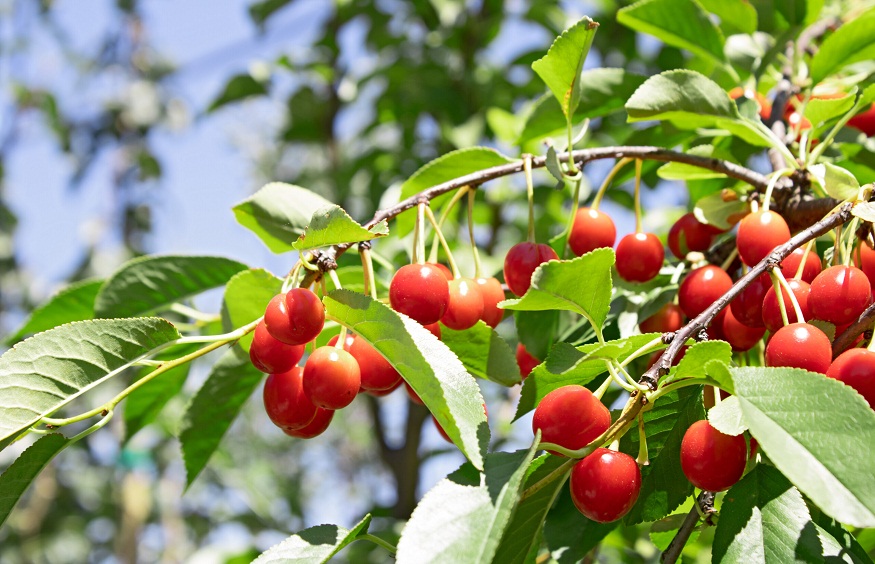
The thought of growing your own fruit trees is an appealing one. From the satisfaction of watching saplings grow into mature trees laden with produce to the joy of picking fresh, homegrown fruit, there are numerous reasons why people choose to plant fruit trees. However, to ensure success, one crucial factor cannot be overlooked—climate. Different fruit trees thrive in different climates, and understanding the role of climate zones is vital to selecting the right trees for your garden or orchard.
Climate has a direct effect on a fruit tree’s health, productivity, and longevity. When you buy fruit trees, it is not merely about choosing your favorite fruit variety but also about choosing the right type that will thrive in your particular climate zone. In this article, we will explore the importance of climate zones and how they influence fruit tree selection, as well as offer practical advice on making the best choices for your specific region.
A nursery specialist at CRJ Fruit Trees advises, “Matching the right fruit tree to your local climate zone will significantly enhance both growth and fruit production, minimizing the challenges that can arise from unsuitable conditions.” This crucial piece of advice sets the stage for understanding the connection between climate and successful fruit tree cultivation.
Understanding Climate Zones
To effectively select the right fruit trees for your garden, it is first essential to understand what a climate zone is. A climate zone, also known as a hardiness zone, is a geographically defined area that categorizes locations based on their average climatic conditions, particularly temperature ranges. In the United Kingdom, the climate varies significantly from region to region. Factors such as temperature, frost frequency, rainfall, and humidity all play roles in determining which fruit trees will flourish.
In Britain, there are several different climate zones that influence what types of fruit trees can grow in specific areas. The southwest, for example, is known for its milder and wetter climate, while the southeast tends to be drier and warmer. Northern areas can be colder, with longer winters and more significant temperature drops, which directly affects the ability of specific varieties to grow. Each fruit tree has particular needs in terms of temperature, growing seasons, and chill hours—all of which are determined by the regional climate.
The Importance of Chill Hours
One of the most important aspects of choosing the right fruit tree is understanding chill hours. Chill hours are the number of hours during the winter season when the temperature falls between approximately 0°C and 7°C. Many fruit trees require a certain number of chill hours to break dormancy and initiate healthy flowering and fruiting. Without sufficient chill hours, the tree might produce fewer blossoms or, in extreme cases, fail to produce fruit altogether.
For example, apple and pear trees typically require a high number of chill hours, making them suitable for regions where winters are cold enough to meet this requirement. On the other hand, some varieties of plums or cherries may require fewer chill hours, making them more adaptable to areas with milder winters. Before you buy fruit trees, it’s essential to check the chill hour requirement of the variety and ensure it matches the winter conditions of your climate zone.
Frost Tolerance and Growing Seasons
Frost tolerance is another key consideration in selecting the appropriate fruit tree. Frost can have a significant impact on fruit trees, particularly during the flowering phase. Late spring frosts can damage blossoms, leading to reduced or failed fruit production. In regions prone to late frosts, selecting frost-tolerant varieties can help mitigate this risk. Apples, for instance, tend to have a higher frost tolerance compared to other fruit trees such as apricots, which can be more sensitive to cold temperatures.
The length of the growing season also influences the choice of fruit trees. Some varieties require a long, warm growing season to produce fully mature fruit. For example, figs and peaches thrive in warmer climates with extended summers, whereas apples, pears, and plums can adapt to shorter, cooler growing seasons. By matching the growing season requirements of the tree to the conditions available in your climate zone, you increase the likelihood of achieving abundant harvests.
Soil and Rainfall Considerations
While temperature and frost tolerance are critical, other climate-related factors such as soil moisture and rainfall must also be considered when choosing fruit trees. Different species have varying tolerances for soil moisture, and climate influences how much natural rainfall will be available throughout the year.
In regions that experience high levels of rainfall, it is essential to consider trees that can handle wetter soils. Plum and pear trees, for example, tend to cope well in wetter conditions compared to more sensitive species like apricots, which prefer well-drained, drier soils. For regions prone to dry summers, it’s wise to choose fruit trees that are drought-tolerant, such as olives or certain fig varieties, or to be prepared to supplement natural rainfall with additional irrigation.
Choosing Fruit Trees Based on UK Climate Zones
The climate in the UK can be broadly divided into several different zones, and each zone supports the growth of specific types of fruit trees. Understanding these general zones can help in selecting fruit trees that will thrive in a given area.
South West England
This area is characterized by a milder climate with higher levels of rainfall. The warmer winters in the southwest make it suitable for growing figs, plums, and even some Mediterranean varieties, provided they have some shelter. Apples and pears also grow well in this region, as the climate provides sufficient chill hours while avoiding extreme cold.
South East England
The southeast tends to be warmer and drier compared to other parts of the country. This region is ideal for growing fruit trees that require more warmth, such as peaches, nectarines, and apricots. However, these species can be vulnerable to late spring frosts, so selecting varieties that flower later in the season is advantageous. Apples and cherries also perform well here, benefiting from the extended growing season and drier climate.
Northern England and Scotland
These areas have cooler temperatures and shorter growing seasons, with colder winters that may bring heavy frost. It is advisable to choose fruit trees with high frost tolerance, such as apples, plums, and pears. These trees are more suited to colder climates and can handle the reduced growing season. Additionally, selecting rootstocks that promote hardiness can help ensure success in these challenging climates.
Wales
Wales generally experiences mild but wet conditions. This climate is suitable for apples, plums, and pears, which can handle the wetter soil conditions. Cherries can also thrive, provided they have good drainage. In particularly sheltered areas, figs may be grown successfully, but they will require careful positioning to protect against harsh winter conditions.
Rootstock Selection and Climate Adaptation
The role of rootstock is often overlooked, but it is crucial for adapting fruit trees to specific climates. The rootstock determines the tree’s size, vigour, and resistance to environmental challenges such as poor soil or frost. Dwarfing rootstocks, for instance, limit the size of the tree, making them suitable for smaller gardens or for areas where soil nutrients might be limited.
Certain rootstocks also provide increased tolerance to wet or dry conditions, as well as better resistance to cold temperatures. When you buy fruit trees, it is advisable to check the rootstock type and ensure that it matches the climate and growing conditions of your location. For example, M26 and MM106 are common apple rootstocks that provide a balance of vigor and hardiness, making them well-suited to the variable climate across much of the UK.
Microclimates and Garden Positioning
In addition to broad climate zones, microclimates—small areas within a garden that have unique conditions—also play a significant role in fruit tree success. Microclimates are influenced by factors such as sunlight exposure, wind protection, and proximity to buildings or bodies of water. Understanding the microclimates in your garden can help you position your fruit trees for optimal growth.
For instance, a south-facing wall can create a warmer microclimate, allowing you to grow fruit trees that require more heat, such as peaches or figs, even in cooler regions. On the other hand, low-lying areas prone to frost pockets may require frost-tolerant species to ensure that late spring frosts do not damage delicate blossoms.
Wind exposure is another aspect that affects tree health. Fruit trees, particularly young ones, can be damaged by strong winds, which can break branches or cause stress that reduces fruiting. Positioning trees in sheltered spots or using windbreaks can help minimize these issues.
Disease Resistance and Climate Considerations
Climate conditions not only influence growth but also play a role in the prevalence of certain diseases and pests. Humid climates, for example, are more conducive to fungal diseases such as apple scab and powdery mildew. Selecting disease-resistant varieties is particularly important in areas where these conditions are common. Some apple varieties, such as ‘Liberty’ or ‘Enterprise,’ have been bred for resistance to scab and other common diseases, making them ideal for wetter climates.
In drier regions, pests like aphids and mites may become more problematic, especially during prolonged periods of dry weather. Choosing varieties that are less susceptible to these pests, or ensuring proper irrigation to reduce tree stress, can help mitigate these challenges.
Adapting to Climate Change
In recent years, climate change has added a layer of complexity to fruit tree cultivation. Warmer temperatures, unpredictable weather patterns, and shifting growing seasons mean that gardeners need to be adaptable in their approach. One way to address these changes is to diversify the types of fruit trees planted. Growing a mix of early and late-flowering varieties, as well as experimenting with trees that may have previously been unsuitable for a particular zone, can help spread the risk associated with unpredictable conditions.
Additionally, improved irrigation techniques, such as drip irrigation, can help conserve water during dry spells, while mulching can reduce evaporation and improve moisture retention around the tree’s root zone.
Conclusion: The Importance of Climate-Aware Fruit Tree Selection
Selecting the right fruit trees involves much more than simply choosing a favorite variety. The success of your orchard or garden depends heavily on understanding your local climate zone, the specific requirements of each tree, and how these factors interact. Whether you live in the mild climate of the southwest, the drier southeast, or the colder north, choosing fruit trees suited to your specific climate will greatly improve your chances of success.
When you buy fruit trees, considering factors such as chill hours, frost tolerance, soil moisture preferences, and disease resistance will ensure that you select varieties well-adapted to your unique growing conditions.
